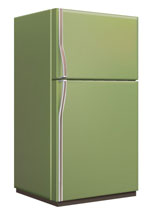When to Replace an Old Refrigerator?
Most of us realize that older appliances use much more electricity than newer models, but are nervous about getting our moneys' worth out of an expensive new appliance. Refrigerators are the single largest user of electricity in the home, but when is it time to throw in the towel and replace an aging fridge with a newer, Energy Star model? Let's investigate. Energy savings may be great enough to warrant replacing a refrigerator that is still working fine; other times, it may be better to get a few more years of service out of the current fridge.
One: Age of Current Fridge
The first thing to look at is the age of the existing refrigerator. On average, a fridge made before 1993 uses about twice as much energy as a new Energy Star rated model. Additionally, as a fridge gets older, its refrigerant starts to wear out and seals start leaking, which leads to even more energy usage. The more energy the refrigerator uses, the more money it costs to run. Since refrigerators run 24 /7, overall energy costs can be considerable.
Two: How Much Energy is the Current Refrigerator Using?

This Green isn't Green
If a refrigerator is older than 1993 (when refrigerator design and technology began to dramatically improve efficiency), it's costing on average $65 more per year to run than a new Energy Star model. Older models use even more power; a fridge made before 1980 can cost over $200 more per year to operate than a new one! If your refrigerator looks like the one pictured at left, it is probably past due for replacement. All refrigerators use different amounts of energy, and Energy Star models are no exception; there is a wide range of energy requirements even in the more efficient Energy Star category. By doing a bit of research, you can find models that use much less energy than the minimum required for Energy Star certification. (Energy Star models are required to use 15% less energy than a comparable standard model. Some models use far less.) Seeking out the most efficient models will reduce the payback time for replacing an old unit.
With over 10 million refrigerators in the U.S. over 10 years old, there is a lot of wasted energy, and lots of opportunity for large-scale gains in overall energy-efficiency. Depending on the age of your current refrigerator, and the efficiency of your new Energy Star model, you can save anywhere from $200 to $1,100 on energy costs over the new fridge's lifetime.
The decision to replace an old refrigerator is a personal one; the bottom line is the older the current model, the quicker you'll recoup the cost of replacing it with an efficient model. If your current refrigerator is around 10 or 15 years old and is still in good working condition, it may be more beneficial to get a few more years out of it.
Choosing a New Energy Star Refrigerator
If you decide that it is time to replace an aging refrigerator, it is important to do your homework as noted earlier. There are many, many models on the market with a dizzying array of features.
The most important thing to do is rely on the Energy Guide Label that is prominently displayed on all new appliances. This simple to use label clearly identifies how much energy the model will use annually, and place that on a range comparing it to other similar models. You can, at a glance, see how much energy the fridge will use, how much that energy will cost on average, and whether it's more- or less-efficient. The goal should be to find a model with an energy rating as far to the left of the scale as possible.
The Energy Star label will also be clearly featured on certified models.
The goal should be to purchase the model that uses the least amount of energy while still having all the features you want and need at a price that fits your budget.
Deciding to Keep an Older Refrigerator
If you've decided to hang on to an older fridge for a while longer, you can still take steps to minimize its energy usage.
- Make sure the temperature is set correctly. Place a small thermometer in the fridge and freezer to gauge the temp. A properly-set fridge should be between 36 and 42 degrees Fahrenheit. The freezer should be right around 3 degrees Fahrenheit. If it's colder than that, adjust your settings; a fridge that's set too cold is wasting energy.
- Seal dishes tightly in the fridge. Uncovered or poorly sealed containers leak moisture from the food within, which makes the fridge work harder than it needs to.
- Make sure the seal on the fridge doors is tight. Place a dollar bill between the fridge and the door; if it can be easily pulled out (or falls out) the seal is not tight enough to keep the cooled air inside. You should have the seal replaced or repaired.
- Keep the fridge full, but not overpacked. Having a stuffed refrigerator restricts the air flow that keeps items cool, requiring more energy to do the job.
- Keep the refrigerator coils clean. The coils underneath the door on the front (or along the back of the fridge if it's older) have to work harder and longer if they're covered with dirt and dust. Cleaning them with a vacuum several times a year will keep things operating efficiently.
Things to Consider
When you replace a refrigerator, there are a couple of things to keep in mind.
First, replacing an old fridge will not save ANY money or energy if you continue using the old unit. Many people buy a new fridge and put the old one in the garage or basement for additional refrigerator space. This defeates entirely the purpose of replacing the old fridge in the first place: energy and money savings.
Instead of consigning the old unit to the garage, make sure it gets recycled and not simply sent to the landfill. Old refrigerators contain over 100 pounds of recyclable steel. Recycling this metal can amount to almost 290 kilowatt hours of electricity. The chemical refrigerant in old refrigerators can also be safely captured and recycled instead of contributing to depletion of the ozone layer. Recycling old units makes the energy savings of their new replacements even greater.
Most retailers today offer recycling for old refrigerators with the purchase of a new one, and will typically pick up the old one when they install the new fridge. It doesn't make any sense to not take them up on the offer.




























































































































































































